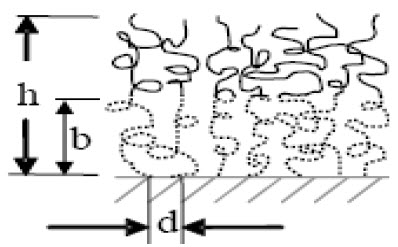Clemson University
Community for the latest research in new membrane materials.

POSTER: Development of Advanced Membranes for Produced Water Treatment
Development of Advanced Membranes for Produced Water Treatment
Introduction
• Produced water (PW) is oily water co-produced during oil and gas exploration and production. • Contains dispersed oils and suspended solids.
Flux (L/m².h)
80 70 70
Daniel Wandera, Scott M. Husson
CHEMICAL & BIOMOLECULAR ENGR. CLEMSON UNIVERSITY
Ranil Wickramasinghe
CHEMICAL ENGR. UNIVERSITY OF ARKANSAS Variation of Initiator Density
350 80 300 90
Results and Discussion
Water Flux Measurements
90
70
Initiator density x 10-19 (g cellulose-1)
80
250
DI Water Flux (L/m².h)
60
50
Flux (L/m².h)
• Estimated 21 billion barrels of PW generated from active oil and gas wells in the US in 2007. • Normally, PW is re-injected in geologically isolated wells or is surface discharged with adverse environmental effects. • Membrane filtration is an option but is affected negatively by fouling and concentration polarization.
60 60
200
50
40
150
50
30
40
40
100 20
30
30 50 10
Unmodified 0.5mM 2-BIB Unmodified PNIPAAm PNIPAAm-b-PPEGMA Unmodified-R PNIPAAm-R PNIPAAm-b-PPEGMA-R
50 60 70 80 90 100 0 0 1 2 3 4 5 6 7 0 0 10 20 30 40
0.25mM 2-BIB 1.0mM 2-BIB
50 60 70
20
20
Unmodified
10
Unmodified-R PNIPAAm - R PNIPAAm-b-PPEGMA - R
50 60 70 80 90 100 10
PNIPAAm PNIPAAm-b-PPEGMA
Initiator Concentration (mM)
Time (min)
Objectives
• Graft poly(N-isopropylacrylamide)-block-poly(oligoethylene glycol methacrylate) by surface-initiated atom transfer radical polymerization (ATRP) from ultrafiltration membranes to limit foulant accumulation and provide an easy, chemical-free way to remove any attached foulants. • Characterize the physiochemical and performance properties of modified membranes.
0 0 10 20 30 40
0 0 10 20 30 40
Time (min)
Time (min)
Systematically varied initiator density by changing initiator (2-BIB) conc.
Direct-flow filtration with model synthetic PW (Left) and actual oilfield PW (Right) at 30 psi.
Effect of varying initiator density on DI water flux, 5 kDa membranes, 30 psi. Higher Initiator density leads to lower flux.
90
Characteristics of model synthetic produced water
Parameter Dispersed oil Conductivity Total Dissolved Solids (TDS) Total Organic Carbon (TOC) Value 5000 mg/L
DI Water Flux (L/m².h)
Variation of Polymerization Time
90 80 80
70
70
DI Water Flux (L/m².h)
1108 µs/cm 543 mg/L 82.23 mg/L
60
60
50
50
40
40
Permeate Quality Specifications for 5 kDa membranes
Membrane Unmodified PNIPAAm PNIPAAm-b-PPEGMA Conductivity (µS/cm) 1038 1024 1021 TDS (mg/L) 508 502 500
7000
30
30
Experimental Methods
Surface-initiated ATRP • Potential for independent control over grafting density and chain length at low polydispersity. • Straightforward to graft block copolymers.
TOC (mg/L) 4.91 3.30 2.02
TOC Removal (%) 94.02 95.99 97.54
20
20
Unmodified Unmodified 1.0h PNIPAAm 0.5h PNIPAAm 2.0h PNIPAAm
0 0 0 10 20 30 40 50 60 70 10 20 30 40 50 10
1.5h PPEGMA 6.0h PPEGMA
60 70
10
3.0h PPEGMA
0
Time (min)
Time (min)
Modified Membrane
6000
Effect of PNIPAAm polymerization time on DI water flux, 5 kDa membranes, 30 psi. Longer time leads to lower flux.
Effect of PPEGMA polymerization time on DI water flux, 5 kDa membranes, 30 psi. Longer time leads to lower flux.
Unmodified Membrane
5000
Conclusions
• Developed membranes for PW treatment with good anti-fouling properties that can be cleaned well by water rinse • Poor salt rejection but excellent TOC removal in all membranes • General decline in flux post modification; flux recovery better for modified membranes
0 10 20 30 40 50 60
Flux (L/m².h)
4000
Membrane Modification Regenerated Cellulose (RC) membranes
Model PW (A), Unmodified 5 kDa membrane permeate (B) and Modified 5 kDa membrane permeate (C).
120
3000
2000
Unmodified 1mM 2-BIB Modified
100
1000
2mM 2-BIB Modified
0
80
Time (h)
Flux (L/m².h)
60
Characterization • ATR FTIR • AFM • Water Flux Measurements
Cross-flow filtration results for 1000 kDa unmodified and modified membranes using model PW at 60 psi and 50 C (Top) Cross-flow filtration results for 5 kDa unmodified and modified membranes using model PW at 40 psi and 50 C (Left).
0 10 20 30 40 50 60 70 80 90
• Modified membranes allow higher cumulative volumes of water to be processed over time prior to cleaning • Initiator density and polymerization time impact water flux, so can be used to tune membrane performance
40
20
Current Work
• Developing an effective self-cleaning protocol
0
Time (h)
Acknowledgements: This work was supported by the National Science Foundation (CBET 0651646). Thanks to Heath Himstedt, Colorado State University. Reference: D. Wandera et al., J. Membr. Sci. 373 (2011) 178–188
